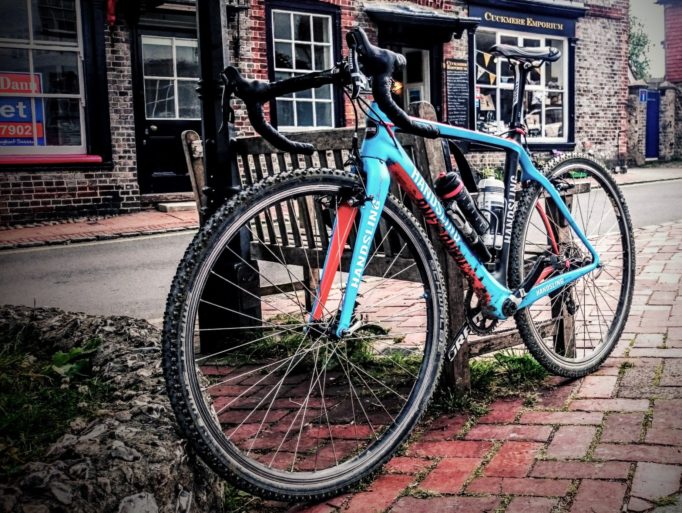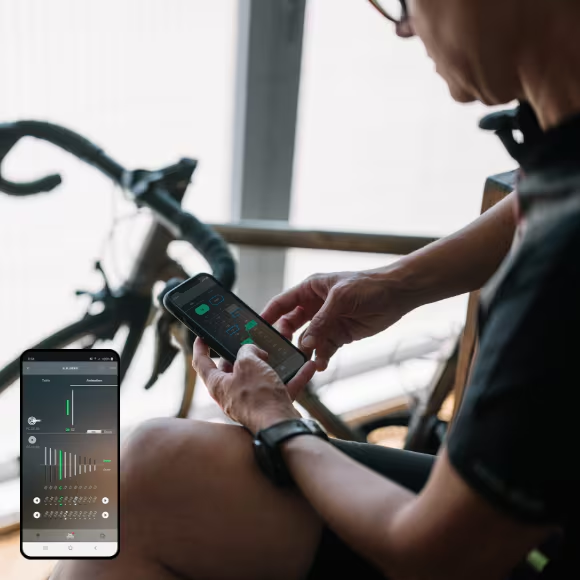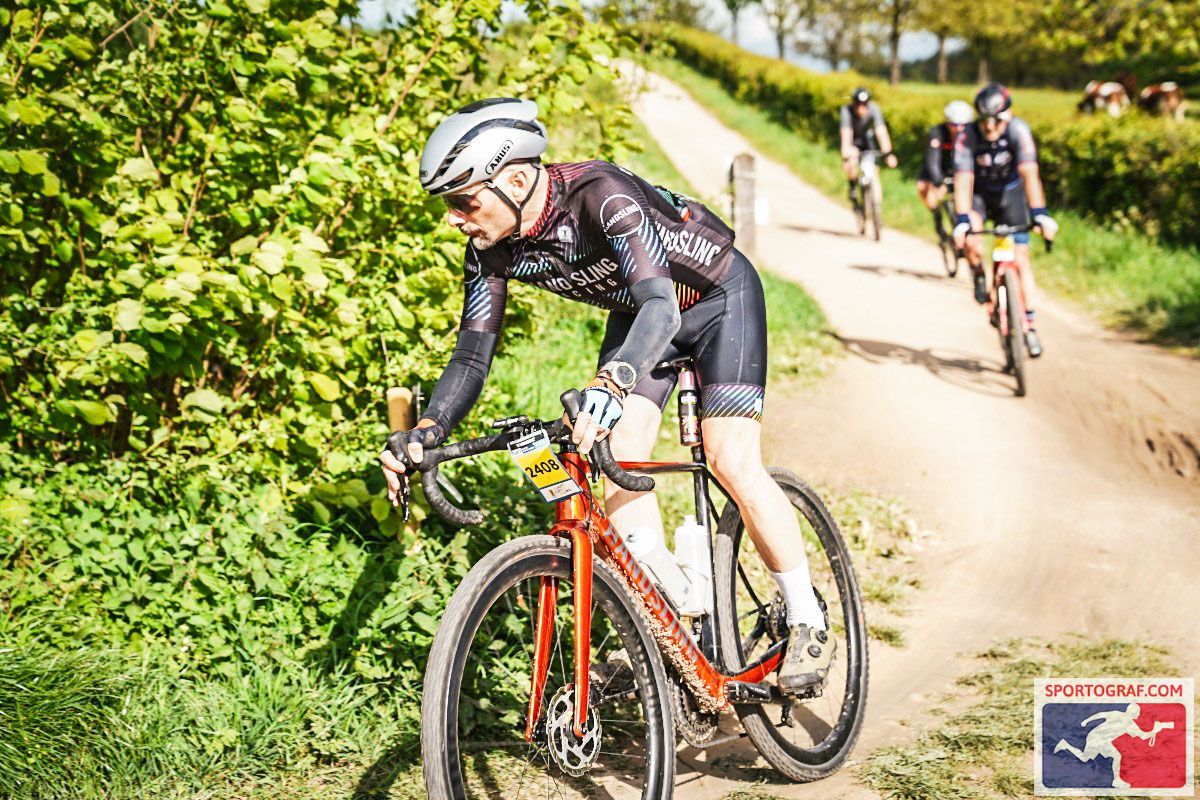Shimano 105 Di2
Shimano 105 Di2 is for me the new do-it-all groupset.
When Shimano 105 Di2 came along a lot of people bemoaned it, “what’s happened to the people’s groupset” they said. It’s too expensive, has no rim brakes and it’s electric. I must admit, I was one of those. However, since those early days I’ve become a convert. What caused that? Simply owning and riding it.

Not long after 105 Di2 came out I was looking to upgrade my cyclo-cross bike, a Handsling CXC. This superb ‘cross race bike is a carbon-fibre 10-speed with mini-V rim brakes. It had endured many seasons of ‘cross racing, multiple editions of the CX Century, CX sportives, UCI gravel races and was my summer training and commuter bike. It was well suited to the job and I loved it. However us cyclists are never happy and I wanted a new bike.

Choosing the frame was simple, the CEXevo is an evolution of my original bike, so I went with what I knew and liked. Things in the world of bike components had moved on since I last chose a bike however. Now, if I wanted a ‘cross bike I was going to have to accept that rim-brakes were no longer an option. Quality, race orientated bikes now only accepted disc-brakes. Not a problem, I’ve been riding MTBs for year, so am used to them.
Disc brakes
When it comes to riding off-road, disc-brakes are so much better. The amount of braking power you have and the ease with which you can apply that power is a game-changer. Previously, riding events like the CX Century – a 100-mile off-road sportive – on rim-brakes was painful. After around 60 miles my forearms would be so sore from braking, that I was reduced to half-power and prayer! Switching to disc-brakes has allowed me to brake with just two fingers, with plenty of control.



Additionally, switching to disc-brakes means I’m no longer wearing out my rims. Every time you apply your brakes you’re abrading the rim. Riding in wet weather off-road makes the situation worse by adding a grinding-paste made up of whatever surface you’re riding on; sand is the worse. And if your rim’s bent out of true, common when riding off road, it won’t affect your braking.
Electronic shifting
So disc-brakes were in and that meant electronic shifting was in as well, why? Well it was the new-kid on the block and I wanted to try it out. Speaking to my fellow riders I couldn’t find anyone who had switched that had a bad thing to say about it. Oh there were plenty that didn’t have it that could say it was terrible. They explained how I would be stuck on the road-side, out of charge and unable to shift. That has yet to happen…

While mechanical shifting is very simple and easy to maintain, it can be finickity. Stretched or gummed-up cables will affect your indexing and can be really annoying when you have to keep double-shifting to make it work. Bent derailleur hangers can make indexing almost impossible and the B screw often laughs at any attempt to make it work! Electronic shifting offered me the chance to enter the world of fit and forget shifting; very tempting. That’s more time riding outdoors, less time fiddling in the garage.
Which brand?
So it was a choice between Shimano, SRAM and Campagnolo for the groupset. I used to be a Campag’ only rider back in the 80s, but since then it’s just got too expensive. If you’re racing regularly and paying for your own kit, it’s just too much. Also I wasn’t a great fan of the sticky-out thumb shifter. So that narrowed it down to Shimano or SRAM. As a part-time mechanic I’d grown to appreciate how well Shimano’s stuff worked. I liked SRAM’s completely wireless operation, but I was used to working with Shimano and had confidence in their products.

Brand chosen, but what tier? Shimano’s top-end groupset Dura-Ace is a thing of beauty and comes with a price tag to match. Next is Ultegra, a groupset I was familiar with, as it had been my go-to for road racing. Reassuringly expensive looking, but cheaper than Dura-Ace, it was what most of us amateurs used. However with electronic shifting now available on 105, I had another choice.
Be more like Danny
Part of what helped me make the choice to go with Shimano 105 Di2, was a conversation I had with a fellow racer way on back when I was regularly racing on the road. Danny was a first-cat rider who ran a local bike shop. We were talking about groupsets and he told me he always raced with Shimano 105. “But why” I asked, “surely you should be on Dura-Ace?” “Not so” said Danny. He reckoned the performance was as good and it saved a heap of money. In his opinion the only real difference was in the finish and look, things that had no impact on his performance. So I decided to be more like Danny!
Reading reports on Shimano 105 Di2 and they all agree on it’s performance. And while it performs well, it also looks good. Not that Danny would be bothered by that! I knew that my new bike was going to doing a lot of gravel riding and racing. That meant I wasn’t going to need a 53-39 and to be honest my days of being able to push those gears were behind me. The 52-36 I chose has been more than adequate for the riding I’m doing now, whether on or off-road. Match it with an 11-36 cassette and I can get up most things. If things get steeper I can always swap to a 50-34 chainset.

Installation
I was actually lucky enough to be get to build my bike up at the Handsling workshop. Here I was able to pester their mechanics about how to go about installing my 105 Di2 groupset. While I’ve had plenty of experience with building up mechanical groupsets, this was my first electronic build. It was actually pretty straightforward, as 105 Di2 is semi-wireless. What this means is that the gear levers connect wirelessly to the derailleurs, while the derailleurs are wired to the battery. The shifters only need to be fixed to the handlebars, from where they communicate with the system. Each shifter is powered by a coin-cell battery, which are easy to find and last around three years!

You have to run the derailleur wires inside your frame – remember external cables? Thankfully you only have to go from the seat-tube to the derailleurs. This operation was over and done in under an hour. There’s a few little tweaks Handsling add to stop the cables rattling inside the frame, which is a nice touch.
Programable shifting!
Once installed and battery charged, it’s time to sync to Shimano’s E-tube app. Setting up the gears is simple and the app runs you through the process. You can set 105 Di2 to work in different ways, which coming from mechanical, is mind-blowing. One of the options allow you to change gear automatically, what Shimano calls synchronised shifting. According to them, “Synchronized Shift is a function that automatically shifts the front derailleur when the rear derailleur is shifted, allowing the derailleurs to work together efficiently.” Which would give you what would feel like a 1x set-up while riding a 2x. There are other options like Multi and auto-shift that I haven’t tried yet.

You can also programme the shifters to work how you want. This is a feature I’ve found very useful for gravel racing. I’ve set my shifters up so that I change the rear derailleur using the two large bottom paddles on each shifter. I find this easier as I suffer from numbness on long off-road events and often have problems finding the smaller button. I use the rear derailleur the most, so having those buttons easy to locate with sausage fingers is a real bonus.
What are they like to live with?
In a word? Simple. 105 Di2 just works, no matter where I’m riding, on or off-road it shifts. Those shifts work even when I’m grinding uphill, something you try and avoid normally. I usually charge them once a month, using E-tube to confirm if I need to. The coin cells in the shifters are still going strong after a year, with hardly any drop in charge. So that worry about running out of charge mid-ride can be countered with simple maintenance. If you’re the kind of rider that never checks things on your bike, then you may run out of charge, but then you’re probably the kind of rider that always has issues with their bike!
A big part of how you feel about a groupset are the shifters. This is the one part of a groupset that you’re actually in contact with. While others will sway you with how fast the shift is, what the derailleur is made from, it’s the shifters that you’ll be holding. Thankfully Shimano have got the shape of the 105 Di2 levers just right.

The ergonomic hoods fit my hands nicely, riding on the hoods is very comfortable. This is a position that I’m in most of the time, so it’s important that it feels right. The front of the hood is what I call slightly Frankenstein, not in a bad way though! I just feel that from the side, the elongated front looks a little like Boris Karloff; maybe it’s just me! Whatever its look however, that shape fits really nicely in your hand. Whether cruising or getting aero, they allow you plenty of comfort and control.
Braking and shifting
Moving to braking and changing gear, both operations are simple from any position. While riding on the hoods, my fingers fall naturally onto the brake levers. These curve slightly outward, which helps position your fingers onto them. If you need to alter the reach, there’s a small grub-screw under each lever. This will give you 16.4mm of adjustment. Shifts are quick and fault free, I’m sure you’ll find some riders that will tell you the higher tier groupsets shift faster, but honestly, I find it hard to discern.


When it comes to braking, I can’t fault them. There’s plenty of power and control on tap and my forearms are enjoying the rest. Whether clattering down a dry dusty chute in the GFL or steep road descents in Sussex I’ve not found them wanting. Of course some will claim that the rotors aren’t as good as their more expensive siblings. Again, from my perspective they do the job and do it well. Ok, I could spend a lot more and get improved performance, but what I have works and works well. I’ll save my cash and put it toward another set of wheels, or a cycling holiday!

Shimano 105 Di2 consumables
For the kind of riding I’m doing on and off-road, with a race once a month, 105 Di2 is perfect. Gravel and cyclo-cross are demanding on your components. There’s crashes, mud and dust, all of which take a toll. Consequently I’m having to change parts more often than I would if just riding on the road. For example, a Dura-Ace 12-speed cassette will set you back around £270. Scroll down to 105 and a HG version is only £65, or alternatively £50 for non-HG. If we look at chains then we’re looking at a £20 difference between the two models. Shimano 105 Di2 will save you money!

Shimano 105 Di2, my conclusion
So there you go. If you’ve been thinking about getting a Shimano 105 Di2 groupset, go for it! Don’t worry that it somehow isn’t ‘good enough’ for racing, if that’s your thing. If you’re a keen amateur or the parent of a young rider, 105 Di2 is more than good enough. And when, inevitably, something breaks or wear out, replacing it won’t break the bank.
Alternatively if you don’t race, but want a quality groupset that is good-looking, light-weight and has bags of performance, it ticks all the boxes. Head over to the Shimano site for all the details. If you want to know more about the Handsling CEXevo, try U23/Elite rider Jack Jee’s review.




